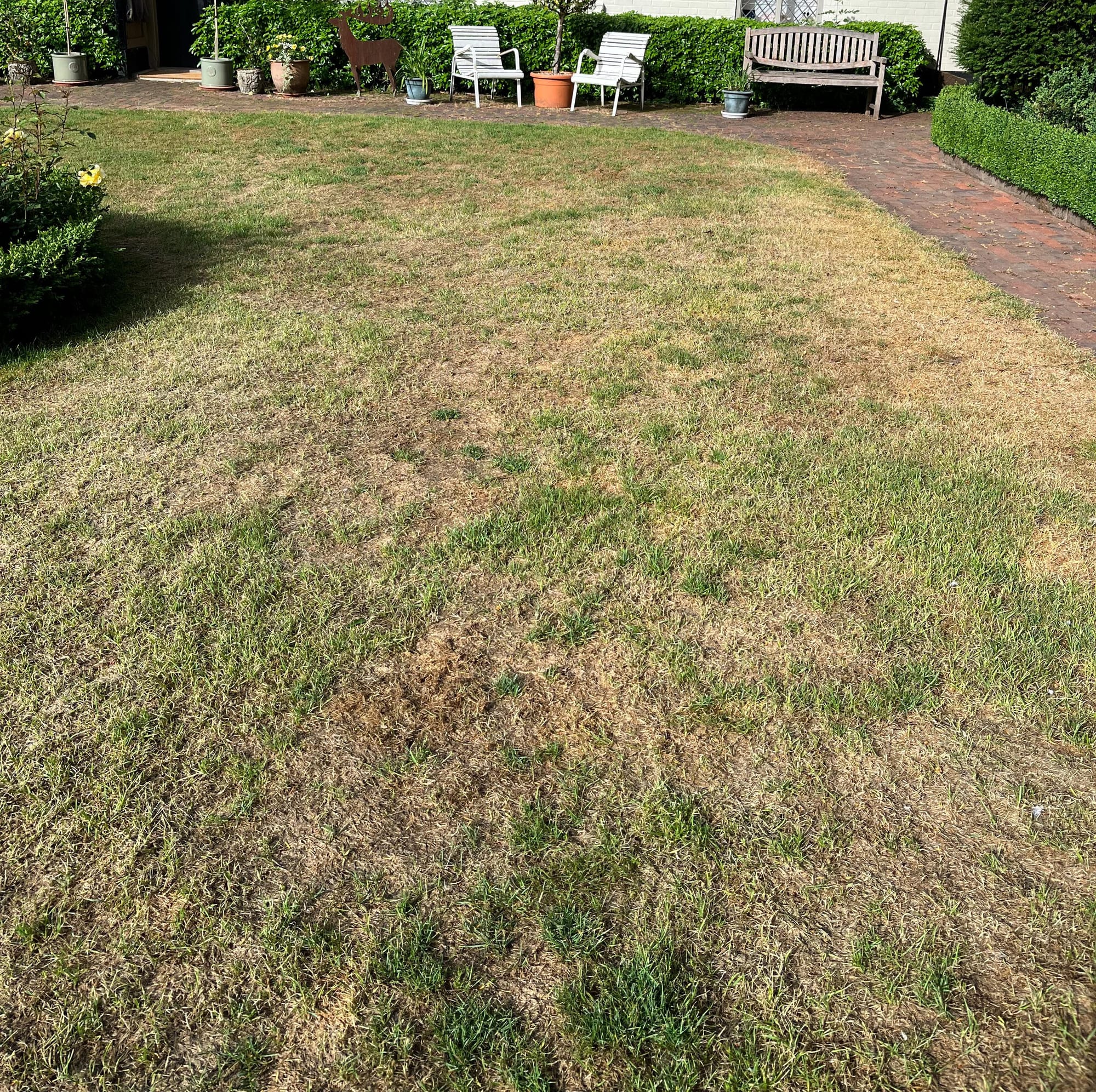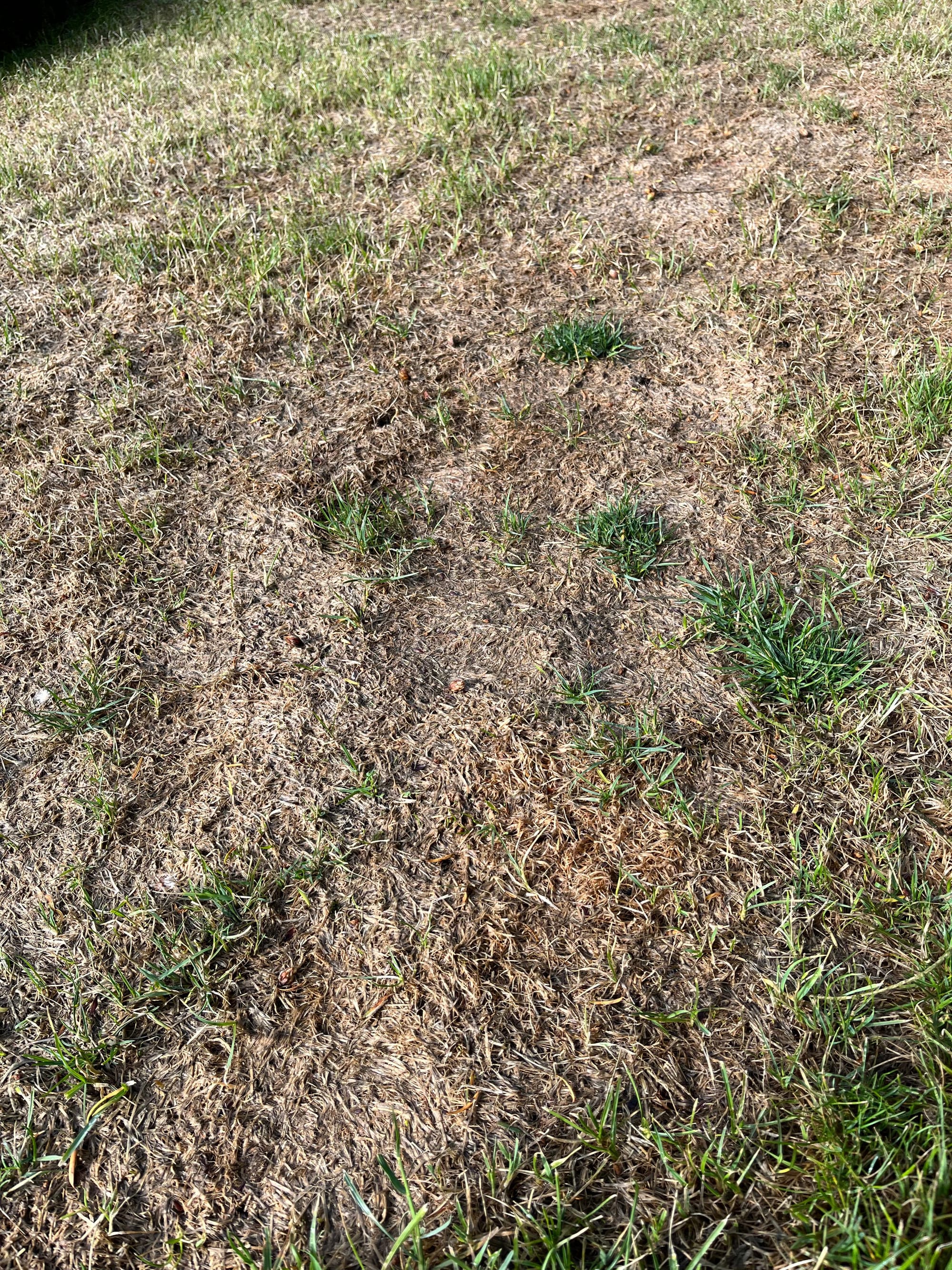Drought Stress – Lawn Survival in Early June [001]
![Drought Stress – Lawn Survival in Early June [001]](/content/images/size/w1200/2025/06/20210729_163618-2.jpg)
Welcome to the first edition of The Lawn Journal — your weekly companion to better lawn care, no matter your experience level. Whether you’re facing a full-blown lawn crisis or just want to learn more about what’s happening beneath your feet, I'm here to help you understand your grass, season by season.
A Harsh Start to June: Is Your Lawn Struggling?
It’s early June, and across much of the UK, lawns are showing signs of stress. After one of the driest springs in recent memory, many people are stepping outside to find their once lush green spaces looking tired and pale. If your grass feels more like walking on crisps than a soft carpet, you're not alone.
This isn’t a failure of effort — it’s simply nature showing her hand. Dry days, high UV rays, drying winds and chilly nights have combined to put many lawns under stress.
There is good news? Most lawns can survive drought stress if you understand what’s happening and respond in the right way. The end of May saw flouries of wet and humid weather across the UK. This brought much needed stress relief to lawns. The previous dry spell through spring was enough to turn lawns brown and drop soil moisture way below ordinary levels for growth.
This week, we’re focusing on exactly that: understanding drought stress, spotting the signs early, and taking the right steps to help your lawn recover.
Keep an eye out over the coming days for any change in the weather. Further afield, drought and heatwaves through summer can set you back, so prepping the lawn early for the inevitable is good insurance.
First Things First: What Does Drought Stress Look Like?
Before jumping into solutions, it’s important to get a clear picture of what drought stress actually is.
Here’s what to look out for:
- Colour change: Grass turning a lighter green, yellowish, or straw-like.
- Dry, crunchy texture: Blades feel brittle instead of flexible.
- Footprints linger: Walk across the lawn and look behind you. If your footprints remain visible for several minutes, the grass is low on water and struggling to bounce back.



Drought stress can appear even in healthy lawns. Areas that are in the shade less should be first to turn yellow.
These changes aren’t just cosmetic. They’re signs that the grass is going into survival mode — slowing down growth and reducing its usual functions to preserve energy and moisture. It’s not dying. It’s defending itself.
What’s Really Going On: The Science Behind the Stress
To understand how to help your lawn, we need to dig a little deeper into what’s happening.
Evapotranspiration: Your Lawn's Water Budget
A key concept here is something called Evapotranspiration (often shortened to ET). It might sound technical, but it’s simple in practice: it’s the total amount of water your lawn is losing through evaporation from the soil and transpiration from the plants themselves.
When:
- The sun is strong,
- The wind is steady,
- The humidity is low,
- And the temperature is high —
… your lawn is losing water fast.
If more water is going out than coming in, your grass will start showing signs of stress. Even if you’re watering occasionally, it may not be enough to keep up. ET rate changes daily as the weather changes.

A simple ET tracker can give a daily estimate for your area
Using an ET tracker will give you an idea of how much water is leaving the plant per day. Use this as a guide for watering practices.
The Morning Footprint Test (Free and Surprisingly Accurate)
One of the easiest ways to check if your lawn is struggling is what we call the Morning Walk Test.
Here’s how to do it:
- Go out early — before the dew has fully dried.
- Walk across your lawn.
- Turn around and observe.
If the grass springs back immediately, it’s doing alright. If your footprints linger, the grass is lacking turgor pressure — the internal water pressure that keeps grass blades upright and firm.
During dry spells, footprints will remain fairly visible during the middle of the day, too. This is when tugor pressure is extremely low, it would be sensible to stay off the lawn to not cause further stress.
No fancy tools required. Just your feet and a few quiet minutes in the garden.
What Your Lawn Needs: Four Practical Steps to Survive a Dry Spell
Now that we’ve diagnosed the problem, here’s how to help your lawn cope and recover.
1. Water Deeply, Not Often
More water isn’t always the answer. Better watering is.
Aim for:
- Early morning (between 6 - 9 AM) or
- Late evening (after 6 PM)
This timing can reduce water lost to evaporation. Try to avoid watering outside of these times, as heat will cause the water to evaporate from the leaf and soil surface rapidly leading to excessive water usage.
When you water, don’t just dampen the surface. Soak the soil.
A good rule of thumb? Most grasses will require 1 inch of water per week. Refer to the ET tracker for a guide and look to water just over that daily amount.
Water until a screwdriver or garden fork can be pushed into the soil without much resistance. This encourages deeper root growth — a key defence against drought.
Avoid light, frequent watering. That keeps roots shallow, making your lawn more dependent on you and more vulnerable to stress.
2. Raise Your Mower Height
Short grass may look tidy, but during dry spells, it’s vulnerable.
Taller grass blades:
- Shade the soil, reducing evaporation
- Provide more surface area for photosynthesis
- Store more energy to help recovery
Raise your cutting height 1-2 clicks while the drought lasts. If you normally cut shorter, it might feel strange, but it’s one of the simplest, most effective changes you can make.
3. Skip the Fertiliser
It’s tempting to feed your lawn when it’s looking tired, but during drought, that’s the wrong move.
Fertiliser — especially nitrogen — encourages new growth. New growth needs water. If your lawn is already stressed, pushing it to grow can make things worse.
Some granular fertilisers will not break down quickly enough and will scorch the grass, making recovery so much harder.
Hold off on feeding until the weather breaks and moisture levels return. Your lawn will thank you for it.
It is important to time fertiliser output windows correctly to avoid the lawn being without nutrients. Start tracking the days you apply fertiliser and keep an eye on the weather during that time to help you.
4. Limit Foot Traffic
Every step on dry grass adds stress. It crushes already-weakened blades and can compact dry soil, making it harder for water to soak in.
Try to:
- Keep play off the lawn
- Redirect pets if possible
- Avoid unnecessary footfall
If your garden sees regular use, consider laying down stepping stones or using temporary paths to preserve the most affected areas.
Going Beyond the Surface: What the Pros Look For
Drought stress is often a symptom of deeper issues in the lawn, not just a lack of rain.
Two common culprits:
Soil Compaction
Hard, compacted soil doesn’t absorb water well. When rain or irrigation hits, it runs off instead of soaking in. Roots also struggle to penetrate compacted soil, meaning your grass can’t access deeper moisture.
Aeration (creating small holes in the soil) helps relieve this issue. More on this in future editions of The Lawn Journal.
Thatch Buildup
Thatch is the layer of dead roots and stems that sits just above the soil - some grass types will produce more than others. A little is normal, but too much acts like a sponge, preventing water from reaching the roots.
If you suspect your lawn has excess thatch, we’ll cover how to manage that later in the season when conditions are right.
What You Can Expect Next
Even with the best care, recovery takes time. Most lawns don’t bounce back overnight — but they do recover.
If you begin watering correctly, raise your mowing height, and avoid stress, you may see fresh green shoots within 7–14 days, especially when rainfall arrives.
You might notice:
- Uneven recovery (some areas bounce back faster)
- Patches that remain stubborn (especially near path edges, slopes, or compacted zones)
- Grass that looks “sleepy” for a while before it perks up
That’s all normal. Be patient and stay consistent.
Your Lawn Is Tougher Than You Think
It’s worth ending on this reminder: grass is built to survive.
Most UK turf grasses can go dormant for weeks, even months, and still come back strong when conditions improve. Browning isn’t always dying — it’s the lawn conserving energy, like a bear hibernating through winter.
The worst thing you can do is panic and throw everything at it — fertiliser, overwatering, mowing too short. Instead, let your lawn rest. Help it where you can. And wait.


With the correct watering programme and a careful eye, lawns can be quite resilient through dry spells.
This Week’s Takeaway
Drought stress is a challenge, but it’s also an opportunity to understand your lawn more deeply, to build its resilience, and to shift from reacting to problems toward preventing them.
Remember:
- Don’t overwater — water deeply and at the right times
- Let your grass grow taller
- Hold off on fertiliser until moisture returns
- Keep off the grass where possible
We’ll be building on these principles throughout the summer.
🌱 Follow The Lawn Journal on social media for weekly tips, videos, and advice you can apply directly to your garden.

Follow @lawn.journal 🌱


